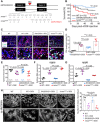Retinoid X receptor alpha is a spatiotemporally predominant therapeutic target for anthracycline-induced cardiotoxicity
- PMID: 32064346
- PMCID: PMC6989136
- DOI: 10.1126/sciadv.aay2939
Retinoid X receptor alpha is a spatiotemporally predominant therapeutic target for anthracycline-induced cardiotoxicity
Abstract
To uncover the genetic basis of anthracycline-induced cardiotoxicity (AIC), we recently established a genetic suppressor screening strategy in zebrafish. Here, we report the molecular and cellular nature of GBT0419, a salutary modifier mutant that affects retinoid x receptor alpha a (rxraa). We showed that endothelial, but not myocardial or epicardial, RXRA activation confers AIC protection. We then identified isotretinoin and bexarotene, two FDA-approved RXRA agonists, which exert cardioprotective effects. The therapeutic effects of these drugs only occur when administered during early, but not late, phase of AIC or as pretreatment. Mechanistically, these spatially- and temporally-predominant benefits of RXRA activation can be ascribed to repair of damaged endothelial cell-barrier via regulating tight-junction protein Zonula occludens-1. Together, our study provides the first in vivo genetic evidence supporting RXRA as the therapeutic target for AIC, and uncovers a previously unrecognized spatiotemporally-predominant mechanism that shall inform future translational efforts.
Copyright © 2020 The Authors, some rights reserved; exclusive licensee American Association for the Advancement of Science. No claim to original U.S. Government Works. Distributed under a Creative Commons Attribution NonCommercial License 4.0 (CC BY-NC).
Figures






Similar articles
-
Calycosin attenuates doxorubicin-induced cardiotoxicity via autophagy regulation in zebrafish models.Biomed Pharmacother. 2021 May;137:111375. doi: 10.1016/j.biopha.2021.111375. Epub 2021 Feb 18. Biomed Pharmacother. 2021. PMID: 33761601
-
Retinoic acid stimulates myocardial expansion by induction of hepatic erythropoietin which activates epicardial Igf2.Development. 2011 Jan;138(1):139-48. doi: 10.1242/dev.054239. Development. 2011. PMID: 21138976 Free PMC article.
-
Modeling, Synthesis, and Biological Evaluation of Potential Retinoid-X-Receptor (RXR) Selective Agonists: Analogs of 4-[1-(3,5,5,8,8-Pentamethyl-5,6,7,8-tetrahyro-2-naphthyl)ethynyl]benzoic Acid (Bexarotene) and 6-(Ethyl(4-isobutoxy-3-isopropylphenyl)amino)nicotinic Acid (NEt-4IB).Int J Mol Sci. 2021 Nov 16;22(22):12371. doi: 10.3390/ijms222212371. Int J Mol Sci. 2021. PMID: 34830251 Free PMC article.
-
Molecular mechanisms of anthracycline induced cardiotoxicity: Zebrafish come into play.Front Cardiovasc Med. 2023 Mar 10;10:1080299. doi: 10.3389/fcvm.2023.1080299. eCollection 2023. Front Cardiovasc Med. 2023. PMID: 36970353 Free PMC article. Review.
-
Genetic Susceptibility and Mechanisms Underlying the Pathogenesis of Anthracycline-Associated Cardiotoxicity.Oxid Med Cell Longev. 2022 Aug 3;2022:5818612. doi: 10.1155/2022/5818612. eCollection 2022. Oxid Med Cell Longev. 2022. PMID: 35965684 Free PMC article. Review.
Cited by
-
Building the vertebrate codex using the gene breaking protein trap library.Elife. 2020 Aug 11;9:e54572. doi: 10.7554/eLife.54572. Elife. 2020. PMID: 32779569 Free PMC article.
-
Cardio-Oncology: Learning From the Old, Applying to the New.Front Cardiovasc Med. 2020 Nov 25;7:601893. doi: 10.3389/fcvm.2020.601893. eCollection 2020. Front Cardiovasc Med. 2020. PMID: 33324688 Free PMC article. Review.
-
Synergistic Effects of Ginsenoside Rb3 and Ferruginol in Ischemia-Induced Myocardial Infarction.Int J Mol Sci. 2022 Dec 14;23(24):15935. doi: 10.3390/ijms232415935. Int J Mol Sci. 2022. PMID: 36555577 Free PMC article.
-
Disruption of MAP7D1 Gene Function Increases the Risk of Doxorubicin-Induced Cardiomyopathy and Heart Failure.Biomed Res Int. 2021 Jul 15;2021:8569921. doi: 10.1155/2021/8569921. eCollection 2021. Biomed Res Int. 2021. PMID: 34327238 Free PMC article.
-
Modeling Susceptibility to Cardiotoxicity in Cancer Therapy Using Human iPSC-Derived Cardiac Cells and Systems Biology.Heart Fail Clin. 2022 Jul;18(3):335-347. doi: 10.1016/j.hfc.2022.02.009. Heart Fail Clin. 2022. PMID: 35718410 Free PMC article. Review.
References
-
- Minotti G., Menna P., Salvatorelli E., Cairo G., Gianni L., Anthracyclines: Molecular advances and pharmacologic developments in antitumor activity and cardiotoxicity. Pharmacol. Rev. 56, 185–229 (2004). - PubMed
-
- Zhang S., Liu X., Bawa-Khalfe T., Lu L.-S., Lyu Y. L., Liu L. F., Yeh E. T. H., Identification of the molecular basis of doxorubicin-induced cardiotoxicity. Nat. Med. 18, 1639–1642 (2012). - PubMed
Publication types
MeSH terms
Substances
Grants and funding
LinkOut - more resources
Full Text Sources
Other Literature Sources
Molecular Biology Databases
Research Materials

